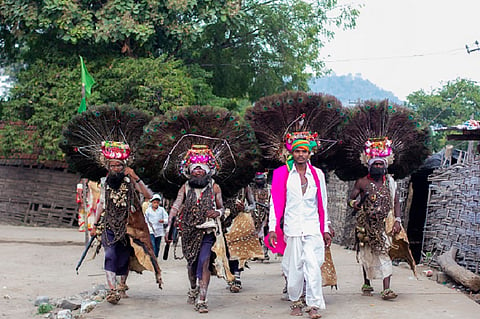

Even in the 21st century, when information can be passed at the click of a button or motorised travel, the Raj Gonds of Adilabad travelled by bullock carts from village to village to spread the cheer of the Keslapur Nagoba Jatara – the tribal festival of the Gond tribes of Adilabad. The Nagoba Jatara is a gentle reminder of how the tribals of the rural Telangana still prefer their ritualistic purity to modernity.
Organised by the Integrated Tribal Development Agency (ITDA), Keslapur Nagoba Jatara which was held from February 4 to 9 this year, is the second biggest tribal carnival held in India and is celebrated by the Mesaram clan of the Gond tribe.
At the Nagoba Jatara this year, Ashok Kumar Vedma, a native of Utnoor mandal in Adilabad, held an interesting display of photographs that exhibited the rich culture of his community, the community of Raj Gonds celebrating the Nagoba Jatara. The youngster had shelled out around Rs 13,500 to set up the exhibition but sadly his collection went unnoticed due to lack of space at the exhibition.
But Ashok Kumar is happy that in a first, someone from his community has been able to document the rich and pristine culture of his community. Ashok, a student at the Jawaharlal Nehru Architecture and Fine Arts University (JNAFAU) in Hyderabad, considers himself lucky to have received an education till his intermediate because his parents were inclined towards getting their children educated. Ashok says he still had to cross hurdles to convince his parents to pursue his dream of being a photographer.
Ashok Kumar
Dreaming to be a photographer in our community is something unheard of. Most of the people still live in the interiors while some have migrated to the nearby towns. In our community in Utnoor, people mostly confine themselves within the traditional jobs and travelling outside Adilabad in itself was a feat I conquered,” Ashok Kumar laughs.
Ashok says he used to be an avid viewer of the Nat Geo channel on television right from his childhood and ever since he wanted to be a wildlife photographer.
“I didn’t know of many options when I finished my Intermediate. But it was through my friend that I came to know about the art school in Hyderabad. I gave the entrance test, got admission and only then did I inform my parents that I was leaving the village,” Kumar says.
Ashok can talk without a pause when it comes to the fervour of the Nagoba Jatara and its prominence among the Gonds. For the community, the festival is the time when most of the marriages are solemnised and women, who have been married into the Gond community, get introduced to their clan goddess. Most importantly, this is the time when people of the community find a voice to take their petitions to the officials of the Utnoor Mandal.
“The Gond community is known for its culture and tradition. We speak the language called Gondi, also called Koya and you can find the Gond people in Chhattisgarh, Maharashtra, Madhya Pradesh, Telangana and Andhra Pradesh. Some elders said that we ruled in Ballarsha, Jabalpur. Even to this day, in my village in Utnoor, we have one of the Gond forts which were ruled by the King Hanumanth Rao,” Ashok shares excitedly.
It’s during the Nagoba Jatara that women buy new pots for cooking, newly-weds are seen in white dresses and masks and the Gonds follow a strict prayer ritual for ten days.
“Nagoba Jatara is mainly celebrated by the Mesaram clan of Gond tribes in Keslapur. People of Mesaram clan offer prayers to the Nagoba (snake) goddess. Major ritual in this Jatara is that they introduce the women who married into the Mesaram clan to the clan goddess, and also a majority of marriages within the community are appropriated during this time. It is again during this Jatara that the government holds a ‘Darbar’. In this darbar, the collector, officials of ITDA and some other government officials will hear petitions of tribal people and people can complain of problems within their villages,” Ashok explains.
The photographs that Ashok have put on display this time explain the rituals accurately.
“The photographs are a collection of the rituals and pertinent moments of the Dandari-Ghusadi festival (another tribal festival) and the Nagoba Jatara during the last three years. If the exhibition had found proper space, it would have been an apt opportunity to draw a contrast with the 40-year-old pictures of British Anthropologist Michael Yorke which were also exhibited in the Jatara,” says Ashok.
Ashok says that in the past many years, there has been a gradual decline in the traditional upkeep of the community’s culture, mainly because of the government’s lack of interest in preserving the culture of the pristine tribes.
“As the government is trying to bring the tribal communities to the mainstream, I have noticed that people in many areas have stopped following rituals and are not able to speak their own language and have forgotten how to play musical instruments like dol, pepre, kalikom and also sing their traditional songs. While modernity is essential, the tribes shouldn’t be robbed off their culture,” Ashok opines.
Ashok says that he is planning to shoot a video documentary about the importance of preserving the culture and also about the education and that culture should not be a hindrance to education, and at the same time, we should not forget our roots.
“Last year, I documented the Pora festival of the Gonds and in upcoming years, I will make documentaries on all tribes of India and introduce their hidden culture to the world. I also want to make some of them come out of the forested areas and compete with the outside world. I had always wanted to become a wildlife photographer, but now as a part of the tribe, I feel it’s my responsibility to save my culture and spread knowledge through the visual medium,” Ashok adds.